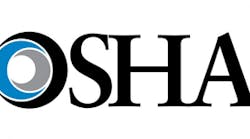President Trump has nominated trucking safety executive Scott A. Mugno to head the Occupational Safety and Health Administration (OSHA), an agency that has been without a leader since January.
If his nomination is confirmed by the Senate, Mugno’s official title will be Assistant Secretary of Labor because OSHA is part of the U.S. Department of Labor. He currently serves as vice president of safety, sustainability and vehicle maintenance at FedEx Ground, the parcel delivery arm of FedEx Corp.
Mugno also is coach of his company’s award-winning driver team that competes in the annual National Truck Driving Championships held by American Trucking Associations. Mugno has been chair or member of several ATA policy committees and currently chairs the American Transportation Research Institute’s Research Advisory Committee.
Although OSHA has been without a head since the beginning of the year, it has continued to pursue its mission—although not in quite as controversial fashion as it did in the Obama Administration, when along with other federal agencies OSHA was observed pursuing a decidedly pro-union tilt.
Actions that raised the hackles of employer groups included expanding joint employer status for franchisers and companies that use temp firms. Another would have allowed union officials to accompany OSHA inspectors even in nonunion workplaces as the employees’ representative, but it was later withdrawn.
Last December, in the waning days of the Obama Administration, OSHA also adopted a rule requiring employers to record and keep records of worker injuries or illnesses for five years. This was in response to a court decision holding that the agency’s enabling law explicitly held that the records only needed to be kept for six months. In April, President Trump signed a congressional resolution striking down the rule.
Another controversial decision mandated that employers file injury and illness reports electronically, which would then be made public on the Internet. Employer groups argued that this would provide a happy hunting ground for unions and tort lawyers.
Under Trump, OSHA has reviewed the injury reporting rule with a view to opening a new rulemaking to revise it, possibly to eliminate the public posting of these reports, and to end other actions that restrict employer safety incentive programs and post-accident drug testing.
Another concern regarding the current electronic reporting system arose in August when it was shut down after the Department of Homeland Security alerted OSHA about a possible security breach. The system was offline for several weeks, but OSHA later said none of the information had been compromised. (The deadline for employers to submit 2016 injury and illness data remains December 1, 2017.)
In the wake of budget cuts, don’t expect Trump to make additional moves that would significantly weaken the agency. During last year’s campaign when he first proposed sweeping regulatory reforms later adopted, such as ordering federal agencies to remove two rules for each one enacted, he excluded regulations dealing with security, safety and health from the automatic cuts.
In terms of its routine operations and even some new initiatives, OSHA has continued to chug along pretty much as it has in the past. Increases in fine amounts that took effect in January remain in place. In addition, for the first six months of this year inspections were on pace to match or exceed 2016’s numbers.
Also, much of the enforcement of federal workplace safety laws has traditionally been left to 26 state agencies, including those of Puerto Rico and the Virgin Islands. (In six of those jurisdictions state enforcement of federal safety laws applies only to state and local government employees.) It’s safe to assume that California’s Cal/OSHA agency, for example, is not backing away from aggressive enforcement under Trump.
What was seen as possible evidence that the Trump-era OSHA will opt for more cooperation than confrontation, was the opening of a proceeding to revise and broaden the Voluntary Protection Programs (VPP). Introduced in 1982, VPP allows employers to adopt written safety and health management plans in exchange for being removed from OSHA’s programmed inspection lists.



